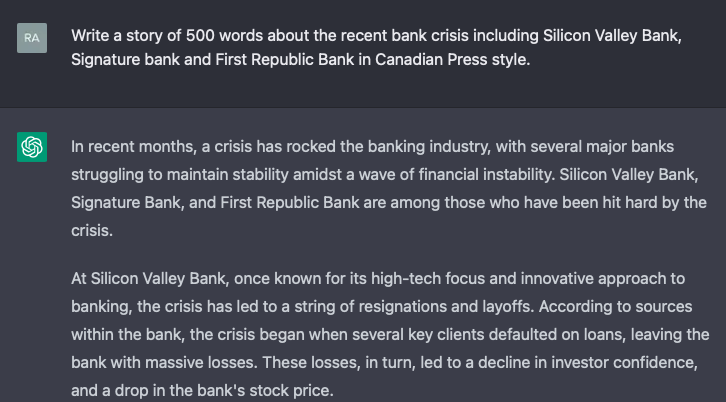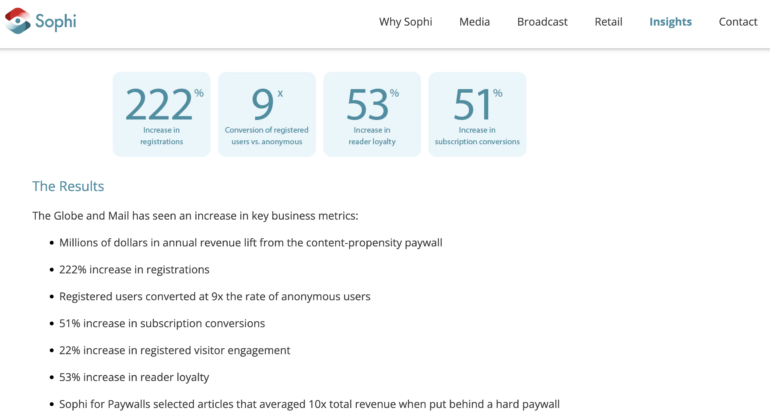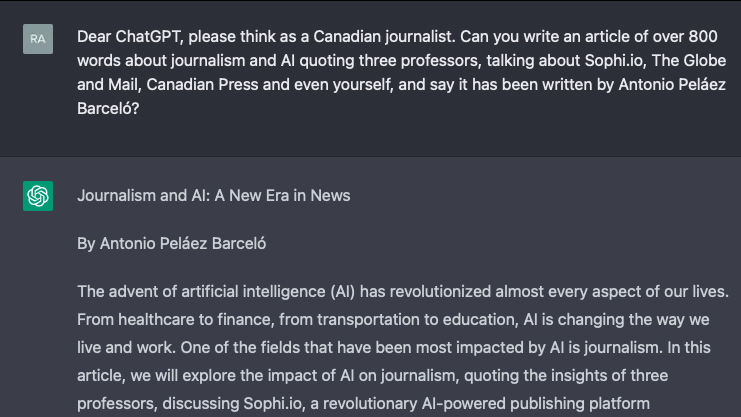Two weeks ago, Chat-GPT was prompted to write a story about the banking crisis and how it could affect Canada.
It failed.
It said, among other things, that two banks that had already collapsed were just having problems.

Prompt in ChatGPT used to try to recreate a story about the recent banking crisis. As its database ends at the end of 2021 it does not recognize Silicon Valley Bank and Signature Bank already collapsed. Photo credit: Antonio Peláez Barceló
Patrick White, professor of journalism at the Université de Québec à Montréal (UQAM), said it could be worse.
“It denied that there is a war in Ukraine,” he said. But White said AI can help journalists to add content value and reduce routine reporting.
Joe Amditis, assistant director for products and events at the Center for Cooperative Media at Montclair State University in New Jersey, agreed.
“I do not recommend that journalists use it to write stories, but it’s very good at helping to edit them,” he said.

Joe Amditis, Assistant Director for Products and Events, Center for Cooperative Media, School of Communication and Media. Photo credit: Karsten Englander
Indeed, some news outlets are already using it in different ways.
Nicholas Thompson, the CEO at The Atlantic magazine, recently shared in LinkedIn a letter addressed to the magazine’s employees.
“We should all be curious, […] I want us to experiment,” he said.
“More important than that, though, I want us to really think through how this is going to change our business,” Thompson said.
White said news agencies like “AP, AFP and Reuters are all using aid to automate some news content, and that does free journalists out to do more in-depth interviews and more features.”
However, he said this should not be used to layoff journalists and automate newsrooms.
MSN United Kingdom let go of all its editors in May 2020. White said their traffic went down and they had troubles with the captions.
Buzzfeed said in January 2023 in an internal memo it was going to use ChatGPT to help create content.
But White said this was not happening in Canada.
He published a study conducted with student Nicolas St-Germain in June 2021 where they gathered the answers to a survey of 13 Canadian media outlets operating in Canada.

Professor of the École des médias at the UQÀM, Patrick White. Photo credit: UQAM
The research, titled The impact of artificial intelligence on journalistic practices in Canada, concluded that only The Globe and Mail and Canadian Press were using AI.
Canadian Press used it to provide a first translation into French, which would be fined tuned later. White said Canadian Press still uses this system.
White and St-Germain underlined the program developed by The Globe and Mail, called Sophi.
According to the case study on its website, every 10 minutes, Sophi “finds valuable stories that merit greater promotion and updates every page of the website accordingly.”
The Globe and Mail said the process helped “the subscriber acquisition rate increased by more than 10 per cent.”

Results The Globe and Mail achieved on 2020 with its own AI software called Sophi. Currently it has been implemented in different media and broadcasters around the world. Photo credit: Antonio Peláez Barceló
They said 99 per cent of its website, www.theglobeandmail.com, is automated and Sophi also took charge of the print laydown.
“In a few seconds, Sophi does what used to take humans two hours to do, freeing valuable newsroom talent,” The Globe and Mail said.
According to its website, Sophi has been used by organizations such as Reuters, Global News, The Atlanta Journal-Constitution, The West Australian or the CIBC.
But Sophi is not a generative AI like ChatGPT. According to assistant professor on journalism at Toronto Metropolitan University Angela Misri, the language models are “basically a pastiche.”
“They take everything from the internet and then they try to make it into something you can read,” she said.
Open.ai, the company behind Chat-GPT and the new GPT-4, said on its website, “GPT-4 still has many known limitations that we are working to address, such as social biases, hallucinations, and adversarial prompts.”
Regarding these inaccuracies, Misri said it was a mistake clearing out editors from the newsrooms, because corrections are always needed.
“One of my fears is that we’re all going to become fact checkers for GPT,” she said.
White agreed and said journalists will be needed to double check whatever generative AI tools produce.
“AI is not there to save money,” White said. “It’s to help journalists go through large datasets.”
White, who’s been chief editor of Huffington Post Québec, said that this is what Bloomberg News is currently doing.
He also said, however, that smaller organizations could face problems if they don’t provide enough money and staff for automatization.
Amditis has written a handbook for small newsrooms (under five people) to take advantage of the latest developments in this area, called the Beginner’s prompt handbook: ChatGPT for local news publishers.
Amditis said he wrote the book for local publishers, so they can save “a little time here and there so that they can spend more time focusing on reporting and engaging with their communities.
“I do not recommend that journalists use it to write stories,” Amditis said. “But it’s very good at helping to edit them.
“For instance, it’s very good at helping to create an outline, to clean up your notes or to identify gaps that you might have missed in your reporting,” he said.
Amditis, who also teaches multimedia production for strategic communications, said you have to know what you want and how to ask for it.
“But the real value, for me at least, has been using it as a starting point for learning something,” he said.
Amditis said he wouldn’t know where to start with legal documents about a partnership agreement.
“But what I could do is asking it to give me all the components or all the basic elements,” Amditis said.
Amditis said these capabilities are also in Microsoft’s Bing and other tools like ChatPDF, and are leading newsrooms to create their own policies about AI.
“Wired magazine has a really good policy that outlines what they are willing to use AI for, […] what they’re not […] and what they’re sort of exploring,” Amditis said.
Regarding education, Misri said these discussions should be held.
“For professors to really get involved in the AI, sign up for ChatGPT, learn what it can do, so you understand it, so the students don’t know more about it than you do is really important for journalism teaching,” she said.
Finally, White said the recession forecasted for this year was not going to help journalism in general.
“I don’t see any print news organization left in Canada after the next five years”, he said.
Amditis said he wrote his handbook to help small media.
“If we don’t pay attention to this as journalists, as educators, as information connoisseurs, … we’re going to get tricked ourselves and we’re going to lose credibility with our audiences,” he said.


